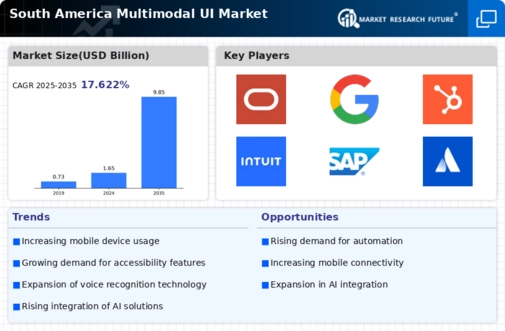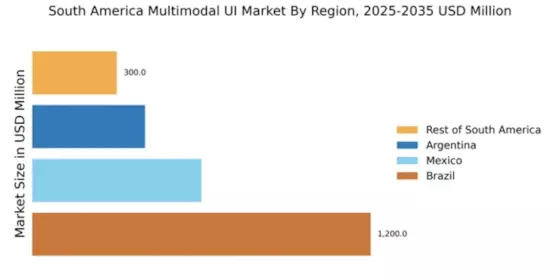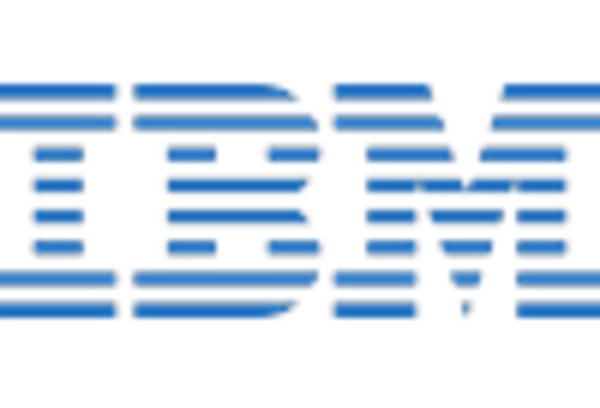Increased Focus on Accessibility
The emphasis on accessibility in technology is becoming a significant driver for the multimodal ui market in South America. As awareness of inclusivity grows, businesses are recognizing the importance of designing interfaces that cater to users with diverse needs, including those with disabilities. The multimodal ui market is responding by creating solutions that integrate various input methods, ensuring that applications are usable by a broader audience. In 2025, it is estimated that around 15% of the population in South America will have some form of disability, underscoring the necessity for accessible design. This demographic shift is likely to compel companies to invest in multimodal interfaces that enhance usability and foster inclusivity, ultimately driving growth in the multimodal ui market.
Technological Advancements in AI
The rapid evolution of artificial intelligence (AI) technologies is a pivotal driver for the multimodal ui market in South America. Enhanced machine learning algorithms and natural language processing capabilities are enabling more sophisticated user interactions. As AI becomes increasingly integrated into applications, the demand for multimodal interfaces that can seamlessly combine voice, touch, and visual inputs is likely to rise. In 2025, the AI market in South America is projected to reach approximately $5 billion, indicating a robust growth trajectory. This growth is expected to fuel investments in multimodal ui solutions, as businesses seek to leverage AI to improve user experiences and operational efficiency. Consequently, the multimodal ui market is poised to benefit significantly from these technological advancements, as companies strive to create more intuitive and responsive interfaces.
Growing Mobile Device Penetration
The proliferation of mobile devices across South America is a crucial factor driving the multimodal ui market. With smartphone penetration exceeding 80% in several countries, users are increasingly accustomed to interacting with applications through various modalities. This trend necessitates the development of multimodal interfaces that can accommodate diverse input methods, such as voice commands, touch gestures, and visual displays. The mobile app market in South America is expected to surpass $10 billion by 2026, highlighting the potential for multimodal ui solutions to enhance user engagement and satisfaction. As consumers demand more versatile and accessible applications, the multimodal ui market is likely to experience substantial growth, prompting developers to innovate and adapt their offerings to meet evolving user preferences.
Rising Demand for Enhanced User Experiences
The increasing expectation for superior user experiences is a driving force behind the multimodal ui market in South America. As competition intensifies across various sectors, businesses are compelled to differentiate themselves through innovative user interfaces. Multimodal solutions that combine voice, touch, and visual elements are seen as essential for creating engaging and intuitive experiences. Market Research Future indicates that companies prioritizing user experience can achieve up to 60% higher customer satisfaction rates. This trend is prompting investments in multimodal ui technologies, as organizations strive to meet consumer demands for seamless interactions. The multimodal ui market is thus positioned to thrive as businesses recognize the value of enhancing user experiences to foster loyalty and drive growth.
Government Initiatives Supporting Digital Transformation
Government initiatives aimed at promoting digital transformation are significantly influencing the multimodal ui market in South America. Various countries are implementing policies to enhance digital infrastructure and encourage the adoption of advanced technologies. These initiatives are likely to create a conducive environment for the growth of multimodal interfaces, as public and private sectors collaborate to improve service delivery. For instance, investments in smart city projects are expected to exceed $20 billion by 2027, which will likely include the integration of multimodal ui solutions. As governments prioritize digital innovation, the multimodal ui market stands to benefit from increased funding and support, facilitating the development of cutting-edge interfaces that cater to the needs of modern users.


















Leave a Comment